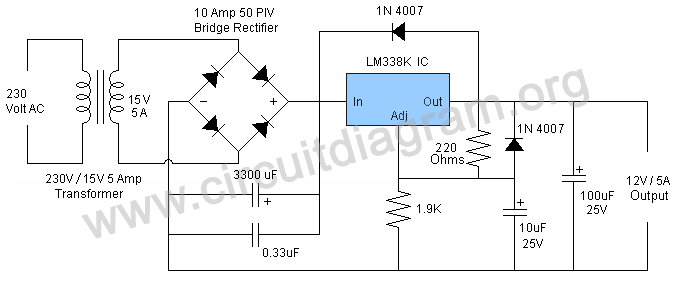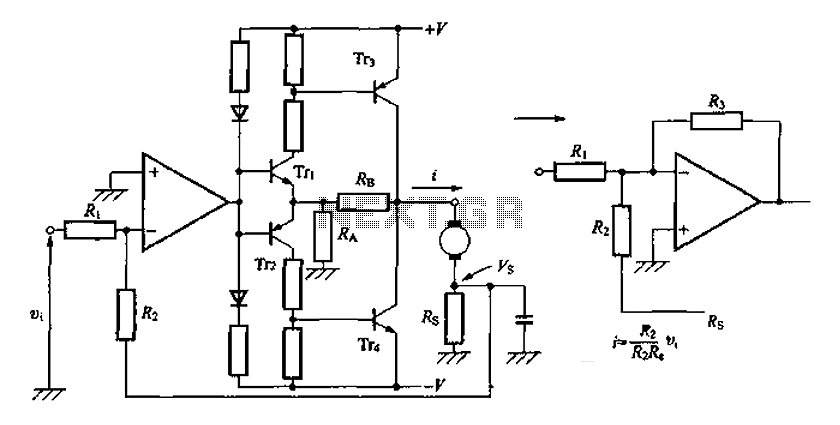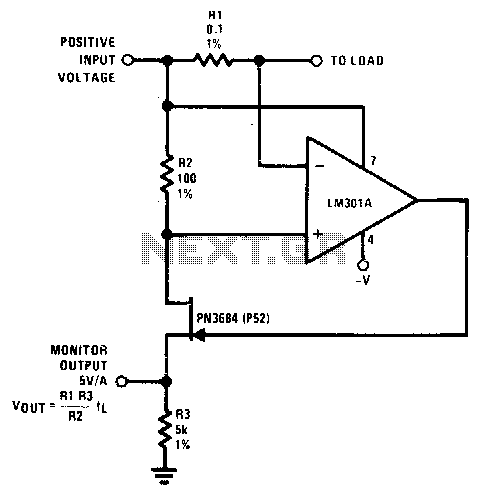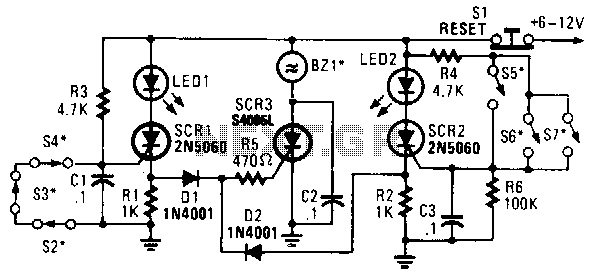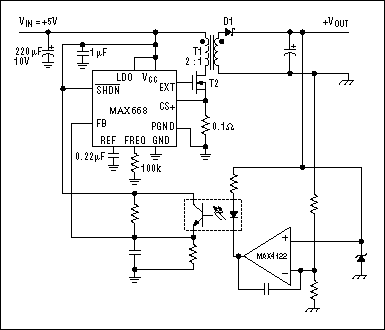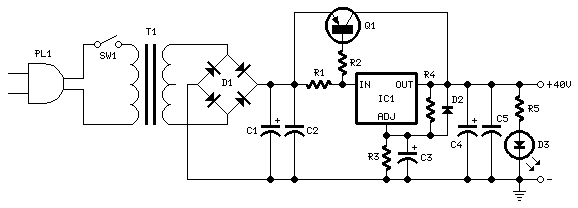
Adjustable Current Limit For Dual Power Supply
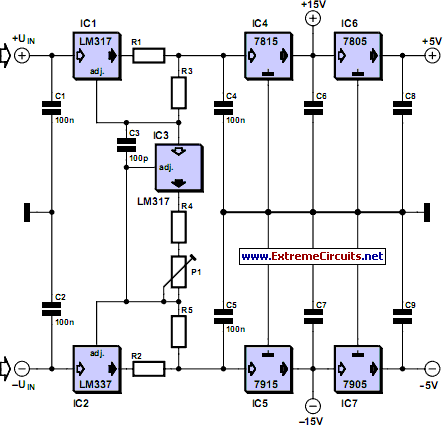
This current-limiting circuit, illustrated as part of a small bench power supply, can be utilized with any dual-rail current source. The section of the circuit to the left limits the current at the input to the dual voltage regulator (IC4 to IC7), ensuring protection against overload. The circuit provides outputs of ±15 V and ±5 V. The voltage regulators (7815/7805 and 7915/7905) do not require further explanation; however, the current-limiting circuit, which includes an LM317 and an LM337, warrants a detailed description. The upper LM317 (IC1) is responsible for managing the current limiting function for the upper branch of the circuit. The innovative aspect lies in the combination of resistors R1 and R3, which are connected between the output and the adjust input of the regulator. In a basic LM317 configuration operating in current-limiting mode (as a constant current source), only one resistor is typically used, across which the regulator maintains a constant voltage of 1.25 V. Consequently, the current is limited to 1.25 V/R. To achieve a maximum current of 1 A, the necessary resistor value would be 1.25 R. However, constructing an adjustable dual-rail current-limited supply in this manner is impractical, as stereo potentiometers with a value of 1.2 R are exceedingly rare. This issue can be addressed by dividing the resistor into two components. Only the resistor at the output of the LM317 (R1) is used for current sensing, while the second resistor (R3) introduces an additional voltage drop based on an adjustable current. The current limiting activates when the sum of the two voltages reaches 1.25 V, allowing for smooth adjustment of the current limit via the current in the second resistor (R3). This adjustment can be performed simultaneously in both the positive and negative branches of the circuit, as depicted in the diagram. It is inefficient to have the current flowing through the second resistor be of the same order as that in the main resistor; therefore, the value of the second resistor is made significantly greater than that of the primary one. If the main resistor (R1) is set to 1.2 R (yielding a maximum current of 1 A), and the second resistor (R3) is set to 120 R, the required voltage drop is achieved with an additional current of 10 mA, maintaining the current limit at 1 A. For the negative branch, the LM337, along with resistors R2 (1.2 R) and R5 (120 R), performs analogous functions. An additional LM317 (IC3) is employed to establish the overall current limit by controlling the supplementary current. The resistance associated with this voltage regulator, configured as a current sink (R4 in series with P1), determines the additional current and, consequently, the output current in both branches. To ensure the total resistance of R4 and P1 equals 120 R, values of 22 R for R4 and 100 R for P1 are utilized, allowing for a broad adjustment range for the output current, from a few milliamps to 1 A. The minimum input voltage for the circuit is contingent upon the desired output voltage and maximum output current. The input to the 7815 must be at least 18 V. An additional 1.2 V + 2.2 V should be considered for the voltage drops across IC1 and R1. Allowing a total of 4 V for the current limiting circuit in each branch indicates that the circuit should be supplied with at least ±22 V to achieve well-regulated outputs of ±15 V and ±5 V. When supplying symmetrical input voltage using a single transformer winding, two diodes, and two smoothing capacitors, it is crucial to ensure that the capacitor values are sufficiently large, as the ripple will be significantly higher than in a full-wave rectification scenario. Depending on the specific application, capacitors C6 to C9 at the outputs of the fixed voltage regulators may utilize electrolytic capacitors rated at 4.7 µF or 10 µF. To enhance stability, electrolytic capacitors can also be connected in parallel with C1, C2, C4, and C5.
The current-limiting circuit described functions effectively to protect the dual voltage regulator from overload conditions while providing adjustable current limits for various applications. The configuration of the LM317 and LM337 in conjunction with resistors allows for smooth adjustments to the output current, accommodating a range of operational requirements. The choice of resistor values and the method of dividing them into two components ensures practicality in achieving the desired current limits without the need for rare components. Additionally, the careful consideration of input voltage requirements and capacitor sizes enhances the reliability and performance of the power supply circuit, making it suitable for diverse electronic projects. The overall design emphasizes efficiency and flexibility, providing a robust solution for applications requiring precise voltage regulation and current limiting.This current-limiting circuit, shown in this example as part of a small bench power supply, could in principle be used in conjunction with any dual-rail current source. The part of the circuit to the left of the diagram limits the current at the input to the dual voltage regulator (IC4 to IC7) so that it is safely protected against overload.
The c ircuit shown produces outputs at ±15 V and ±5V. The voltage regulators at the outputs (7815/7805 and 7915/7905) need no further comment; but the current-limiting circuit itself, built around an LM317 and an LM337, is not quite so self-explanatory. The upper LM317 (IC1) manages the current limiting function for the upper branch of the circuit. The clever part is the combination of the two resistors R1 and R3 between the output and the adjust input of the regulator.
In the basic LM317 configuration in current-limiting mode (i. e. , as a constant current source), just one resistor is used here, across which the regulator maintains a constant voltage of 1. 25 V. The current is thus limited to a value of 1. 25 V/R. To obtain a maximum current of 1 A, for example, the formula tells us that the necessary resistor value is 1.
25R. Unfortunately it is not practical to try to build an adjustable dual-rail current-limited supply in this way, as stereo potentiometers with a value of 1. 2R are extremely difficult, if not impossible, to obtain. We can solve the problem using the technique of dividing the resistor into two resistors. Only the resistor at the output of the LM317 (R1) serves for current sensing. The second resistor (R3) causes an additional voltage drop depending on an additional (and adjustable) current.
When the sum of the two voltages reaches 1. 25 V current limiting cuts in. This makes it possible to adjust the current limit smoothly using the current in the second resistor (R3). This can be done simultaneously in the positive and negative branches of the circuit, as the diagram shows.
It would of course be wasteful to arrange for the current flowing in the second resistor to be of the same order of magnitude as the current in the main resistor. We therefore make the value of the second resistor considerably greater than that of the main one. If the main resistor (R1) has a value of 1. 2R (giving a maximum current of 1 A), and the second resistor (R3) a value of 120R, the necessary voltage drop is achieved using an extra current of 10 ent limit will be 1 A.
For the negative branch of the circuit the LM337, along with resistors R2 (1. 2r) and R5 (120R), performs the same functions. A further LM317 (IC3) is used to set the overall current limit point by controlling the additional current. The resistance used with this voltage regulator, wired as a current sink (R4 in series with P1) determines the additional current and therefore also the output current in both the negative and positive branches of the circuit.
Since we also want the total resistance of R4 and P1 to be 120R, we use a value of 22R for R4 and 100R for P1 to give a wide adjustment range for the output current from a few milliamps to 1A. The minimum input voltage for the circuit depends on the desired output voltage and maximum output current.
The input to the 7815 should be at least 18 V. We should allow approximately a further 1. 2 V + 2. 2 V for the voltage drops across IC1 and R1. If we allow a total of 4V for the current limiting circuit in each branch, this means that the circuit as a whole should be supplied with at least ±22 V to produce well-regulated outputs at ±15 V and ±5V. If the symmetrical input voltage is to be provided using a single transformer winding, two diodes and two smoothing capacitors, it important to ensure that the capacitor values are sufficiently large, as there will be considerably more ripple than there would be with full-wave rectification.
Depending on the application, capacitors C6 to C9 at the outputs of the fixed voltage regulators can be electrolytics with a value of 4. 7 µF or 10 µF. To improve stability, electrolytic capacitors can also be connected in parallel with C1, C2, C4 and C5.
🔗 External reference
The current-limiting circuit described functions effectively to protect the dual voltage regulator from overload conditions while providing adjustable current limits for various applications. The configuration of the LM317 and LM337 in conjunction with resistors allows for smooth adjustments to the output current, accommodating a range of operational requirements. The choice of resistor values and the method of dividing them into two components ensures practicality in achieving the desired current limits without the need for rare components. Additionally, the careful consideration of input voltage requirements and capacitor sizes enhances the reliability and performance of the power supply circuit, making it suitable for diverse electronic projects. The overall design emphasizes efficiency and flexibility, providing a robust solution for applications requiring precise voltage regulation and current limiting.This current-limiting circuit, shown in this example as part of a small bench power supply, could in principle be used in conjunction with any dual-rail current source. The part of the circuit to the left of the diagram limits the current at the input to the dual voltage regulator (IC4 to IC7) so that it is safely protected against overload.
The c ircuit shown produces outputs at ±15 V and ±5V. The voltage regulators at the outputs (7815/7805 and 7915/7905) need no further comment; but the current-limiting circuit itself, built around an LM317 and an LM337, is not quite so self-explanatory. The upper LM317 (IC1) manages the current limiting function for the upper branch of the circuit. The clever part is the combination of the two resistors R1 and R3 between the output and the adjust input of the regulator.
In the basic LM317 configuration in current-limiting mode (i. e. , as a constant current source), just one resistor is used here, across which the regulator maintains a constant voltage of 1. 25 V. The current is thus limited to a value of 1. 25 V/R. To obtain a maximum current of 1 A, for example, the formula tells us that the necessary resistor value is 1.
25R. Unfortunately it is not practical to try to build an adjustable dual-rail current-limited supply in this way, as stereo potentiometers with a value of 1. 2R are extremely difficult, if not impossible, to obtain. We can solve the problem using the technique of dividing the resistor into two resistors. Only the resistor at the output of the LM317 (R1) serves for current sensing. The second resistor (R3) causes an additional voltage drop depending on an additional (and adjustable) current.
When the sum of the two voltages reaches 1. 25 V current limiting cuts in. This makes it possible to adjust the current limit smoothly using the current in the second resistor (R3). This can be done simultaneously in the positive and negative branches of the circuit, as the diagram shows.
It would of course be wasteful to arrange for the current flowing in the second resistor to be of the same order of magnitude as the current in the main resistor. We therefore make the value of the second resistor considerably greater than that of the main one. If the main resistor (R1) has a value of 1. 2R (giving a maximum current of 1 A), and the second resistor (R3) a value of 120R, the necessary voltage drop is achieved using an extra current of 10 ent limit will be 1 A.
For the negative branch of the circuit the LM337, along with resistors R2 (1. 2r) and R5 (120R), performs the same functions. A further LM317 (IC3) is used to set the overall current limit point by controlling the additional current. The resistance used with this voltage regulator, wired as a current sink (R4 in series with P1) determines the additional current and therefore also the output current in both the negative and positive branches of the circuit.
Since we also want the total resistance of R4 and P1 to be 120R, we use a value of 22R for R4 and 100R for P1 to give a wide adjustment range for the output current from a few milliamps to 1A. The minimum input voltage for the circuit depends on the desired output voltage and maximum output current.
The input to the 7815 should be at least 18 V. We should allow approximately a further 1. 2 V + 2. 2 V for the voltage drops across IC1 and R1. If we allow a total of 4V for the current limiting circuit in each branch, this means that the circuit as a whole should be supplied with at least ±22 V to produce well-regulated outputs at ±15 V and ±5V. If the symmetrical input voltage is to be provided using a single transformer winding, two diodes and two smoothing capacitors, it important to ensure that the capacitor values are sufficiently large, as there will be considerably more ripple than there would be with full-wave rectification.
Depending on the application, capacitors C6 to C9 at the outputs of the fixed voltage regulators can be electrolytics with a value of 4. 7 µF or 10 µF. To improve stability, electrolytic capacitors can also be connected in parallel with C1, C2, C4 and C5.
🔗 External reference
Warning: include(partials/cookie-banner.php): Failed to open stream: Permission denied in /var/www/html/nextgr/view-circuit.php on line 713
Warning: include(): Failed opening 'partials/cookie-banner.php' for inclusion (include_path='.:/usr/share/php') in /var/www/html/nextgr/view-circuit.php on line 713
